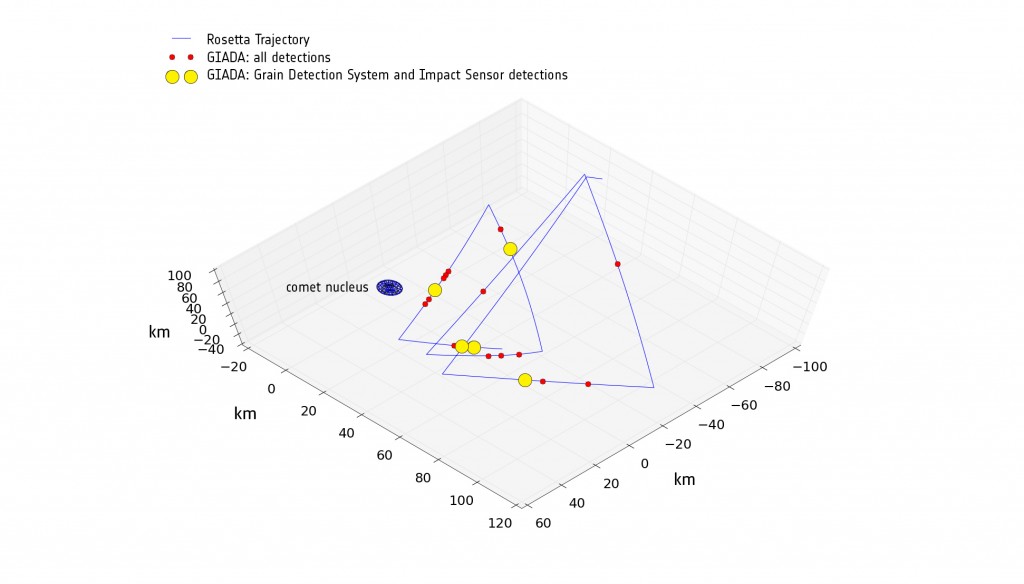Following the trail of a minuscule dust particle through the depths of space may seem far-fetched, but that is effectively what the GIADA team have been doing recently, as they described at the European Planetary Science Congress this week.
During the Rosetta special session at EPSC, the GIADA team reported the detection of 27 dust grains associated with Comet 67P/Churyumov-Gerasimenko during the month of August.
Four of the grains were detected as Rosetta was approaching the comet, nine during the first series of pyramid trajectories at a distance of about 90 km from the comet surface, and the other fourteen along the second series of pyramid trajectories at 60 km distance.

Positions along the Rosetta flight path of 27 dust grains (red dots) detected by GIADA in August 2014. Five grains (yellow dots) were detected by both the Grain Detection System and the Impact Sensor.
Image credit: ESA/Rosetta/GIADA/Univ Parthenope NA/INAF-OAC/IAA/INAF-IAPS
Of the 27 grains, five were seen by the Grain Detection System, which detects the grains and measures some of their optical properties, and also by the Impact Sensor, which measures their momentum.
Thus for this handful of grains, the team were able to measure their masses and velocities. Such measurements are particularly important, as they will allow the scientists to trace the paths of grains back to the comet and to even identify which regions on the comet they may have been ejected from. For these first five grains, that analysis is on-going.
The figure above shows the positions along the Rosetta flight path of 27 dust grains (red dots) detected by GIADA in August 2014. Five grains (yellow dots) were detected by both the Grain Detection System and the Impact Sensor. Some of the data points overlap or are hidden behind the yellow symbols.









Discussion: 14 comments
Is it surprising to the GIADA team that only such a small fraction of particles was detected by both GDS and IS?
It is actually not surprising considering the combined sensitivity of the GDS and IS sub-systems.
On many of the NavCam images I have noticed bright specks which I have assumed were casue by cosmic ray hits on the CCD camera image detectors. However, I wonder if we are not seeing dust grains drifting across the field of view?
Here is a listing of the many experiments and instruments carried on the spacecraft:
https://nssdc.gsfc.nasa.gov/nmc/experimentSearch.do?spacecraft=Rosetta
Useful because I barely remembered what GIADA did and how it worked…
–Bill
On planet earth the density of dust in the air you breath is several magnitudes denser then around rosetta. So take your telephoto camera outside and make some photos then count the dust grains in these pictures and divide this number by 1 000 000. That is what osiris has in its FOV.
Hi Erich,
thanks for the nice comparison.
Just remember that the visibility of dust is also a matter of contrast: the blackness of space and the hard shadows on C-G does little to obscure a sunlit dust paticle, whereas the diffuse light and lit backgrounds on earth is a different thing: think of rain in the headlight of a car.
Is there any other information that you can release about the dust, There should of been some spectural analysis by now that would give us some clues of what they are? Especially is the chemistry that of agregation in a cold primordial soup, or is there evidence of more advanced structure meaning that the comet might not be primordial, rather coming from an exiting planet?
So far specular analysis is all we get
Which is the order of magnitude of the relative speed between Rosetta and the comet, now that it is in orbit?.
The orbiting speed of rosetta is about meter per second range
At a geostationary orbit it revolves 12.7 hour per turn at a radius if 3.3km makes a bit under a halve meter per second, further out its a bit faster but not very much.
This is all very slow motion do not compare this with orbits around earth.
The rosetta follows the comet and the relative speed is lowest possible as we want to follow it for quite some time. Its orbiting.
is simple dust grains cause us so much expectation, imagine when we go down
On the next mission we must bring a vacuum cleaner to clean the vacuum. For the surface a mop is the right tool.
Surely the comparison to dust in the earths atmosphere is rather missleading. The behaviour of that dust is determined by gravity -large particles fall out rapidly – and by the interaction of smaller particles with the air. So there are a lot of particles – but they are very small, and essentially invisible.
None of that is true around 67P, In hard vacuum and extremely low gravity. Gently throw up a handful of sand, and it will happily float around, not fall back to earth as here.
A far smaller density of larger particles could be much more visible than dust in the earth’s atmosphere.
I’m certainly not suggesting the bright points are in fact dust; don’t have the data; just that the comparison the dust in the earths atmosphere is perhaps unsafe.
Don’t be misled by the images – the surface of the comet is black (blacker than a black t shirt) – it reflects only 2-3% of the sunlight hitting it – and other instruments have found no surface ice. Therefore any particles shed are also highly likely to be black and would not show up in any navcam pictures, which have a resolution of meters per pixel.